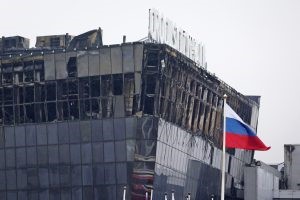There was a major terror attack in Russia and Western Media told us it was ISIS. Well, It wasn’t.
Let us look at some indicative signs. The Kiev regime has been employing terror tactics in non-military zones within Russia, such as Belgorod and Kursk. There has been an intentional effort by the Ukrainian government and its backers to extend the conflict into Russian territory, far from the frontline. Additionally, there were signs of threats from Western leaders towards Russia. A notable example would be a statement by Victoria Nuland, former U.S. Under Secretary, hinting at unforeseen challenges for the Russian government, which alludes to potential sabotage activities within Russia. Then there was the telltale warning by the American Embassy to U.S. nationals to avoid public gatherings in Moscow due to terrorist threats, without corresponding coordination with Russian officials. This sequence of events, marked by veiled threats and indirect actions, were signs that hinted at something big that was about to be played out in the Russian mainland.
Join us on Telegram: https://t.me/tfiglobal
The terrorist attack at Crocus City Hall on the outskirts of Moscow resulting in over 130 civilian casualties, including children, on March 22, marks a disturbing moment. The incident, which stands as one of the gravest tragedies to date, has a death toll anticipated to increase due to the critical condition of several individuals. Russian security forces swiftly responded, apprehending eleven individuals connected to the attack, among them the four gunmen. These assailants, identified as Tajik immigrants with alleged links to radical Islamic factions, were captured attempting to flee across the Bryansk oblast border into Ukraine.
During interrogation, the captured individuals claimed recruitment through Telegram, stating they were provided with weapons for the attack and promised a financial reward. In the aftermath, Western media speculated on the involvement of ISIS, a narrative unsupported by the ongoing investigation. Contrarily, American outlets explicitly dismissed Ukrainian involvement, focusing instead on Islamic extremism. This narrative was divergent from the facts which were yet to be established. The western media narrative completely ignored motivations and affiliations and went ahead with stories that were more about exonerating Ukraine rather than solving the case.
Read More: Russia releases “Foreign Mercenaries” Hit Count
ISIS is not the ISIS the world was once scared of. ISIS has been weakened significantly by Russian efforts in Syria, and it lacks the capability for such large-scale attacks. Its remnants operate in scattered militias across various countries, including within anti-Russian factions in Ukraine. The attackers at Crocus City Hall acted as mercenaries, without evident links to ISIS or its ideologies. Their aim was monetary, not ideological, differing from ISIS’s typical suicide missions for “martyrdom.”
Also, one of the most intriguing aspects is the escape route. The terrorists’ escape attempt through the heavily fortified Bryansk border, laden with Russian military and minefields, underscores the high risk of their route. Historically, even Ukrainian forces have not attempted land invasions here, highlighting the area’s defensibility. This daring escape suggests significant backing, likely from Ukrainian intelligence, providing detailed navigation to bypass Russian defenses, challenging Western claims of Kiev’s non-involvement in the attack.
The West’s motives to obscure Ukrainian involvement in such incidents are clear, as Kiev rarely operates independently in its actions, but always in collaboration with Western allies. As Ukraine is significantly influenced by Western directives, any Ukrainian participation in the Moscow attack would imply Western involvement, suggesting a coordinated effort between Ukrainian agents and their Western counterparts.
Read More: France Set to Deploy Troops to Ukraine – Russia’s Chief Spy
The Moscow terrorist attacks coincide with a rise in Ukrainian border incursions, suggesting a shift towards asymmetrical warfare tactics by the neo-Nazi regime amid military setbacks.
This strategy aims to destabilize Russia internally, making citizens feel unsafe and encouraging dissent against the government. By evoking memories of the turbulent 1990s and 2000s, when major Russian cities were targeted, Western intelligence seeks to undermine the government’s legitimacy, hoping to trigger a domestic crisis.
